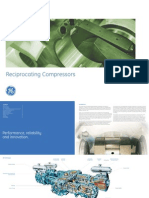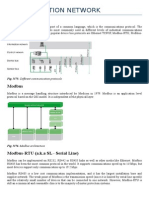A 10 605 1
A 10 605 1
Uploaded by
matteo2009Copyright:
Available Formats
A 10 605 1
A 10 605 1
Uploaded by
matteo2009Original Description:
Original Title
Copyright
Available Formats
Share this document
Did you find this document useful?
Is this content inappropriate?
Copyright:
Available Formats
A 10 605 1
A 10 605 1
Uploaded by
matteo2009Copyright:
Available Formats
1
Efficiency and heat losses of indirect water bath heater
installed in natural gas pressure reduction station;
evaluating a case study in Iran
1.Ebrahim Khalili, 2. Esmaeil Heybatian
1. Researcher of National Iranian Gas Company (NIGC)
2. General director of Shahrekord Gas Company
Corresponding Author E-mail:khalili@nigc-chbgas.ir
Abstract
Indirect fired water heaters are typically used to raise the temperature of fluids such
as natural gas. Without heaters, gas freezing (because of Joule-Thomson effect) can
occur, while it is passing through the pressure reduction installation, damaging valves
and instrumentation, or even causing gas supply interruption.
At present, water-bath heater is widespread used for gas industry to heat the natural
gas. Its large size, the need for water reposition, its low thermal efficiency and large
heat losses from flue gas (exhaust) are the main operational problems of the
traditional equipment.
In this paper energy calculations in all parts of a typical heater have been considered.
Then main energy losses, specially from chimney was calculated and then the heater
efficiency was obtained.
As a case study, one city gate station (CGS) located in Shahrekord city with nominal
capacity of 120,000 SCMH has been considered. Based on statistical data collected
from station during one year, calculations showed that more than 38% of combustion
energy will be lost through the stack and into the ambient. It also has been observed
that about 2% of losses is from the heater surfaces. The heater efficiency of this test
case is less than 47%. The total energy losses from stack and surfaces in the year
under study were 4667Gj and overall gas consumption for burners was 411000m
which approximately costs about 137000$.
Keywords: Energy losses, gas pressure reduction station, Stack losses, efficiency
2
Fig.1: Typical configuration of water bath heater
Fundamental of combustion and heat losses
The process of the combustion in the fire tube heater is supposed to be a steady
state process at a constant pressure and all gases are ideal. Natural gas is a
complex multi component mixture of a number of saturated hydrocarbons: methane,
ethane, propane, and butane and its isomers. Nitrogen, hydrogen sulfide, helium,
argon, water vapor, and other components are contained in small amounts in natural
gases. The analysis of natural gas from the test case location is shown in table 1
[1,2].
Table 1: Volumetric Analysis Of Natural Gas (Shahrekord Station-Iran)
Constituent Percent by volume
Methane (
4
CH ) 89%
Ethane (
2 6
C H ) 4.1%
Propane (
3 8
C H ) 1.2%
Nitrogen (
2
N ) 5%
Carbon dioxide
2
CO 0.7%
Considering above compositions, gives us a density of 0.717 kg/m and the heat
value of 8400 kcal/m for natural gas in the station. By thermo-dynamical calculations
we determined the exact value of the constant-pressure specific heat of natural gas,
as a function of temperature[3]:
Pmix i p i
c = X c
(1)
Where parameter
i
X represents the mass fraction of constituent and
p i
c is its specific
heat. Substitution the related values for fuel gives:
-3 -7 2 -10 3
( / . ) 1.07 3.22 10 3.89 10 - 5.55 10
P
c kj kg K T T T
= + + (2)
where T varies from
250 K<T<1200 K.
3
To ensure complete combustion, even modern equipment with many features must
operate with excess air. Also for simplicity we supposed the methane as combustion
fuel so the general equation of combustion reaction of this hydrocarbon fuel and air is
written as[3]:
a b 2 2 2
2 2 2 2
C H +A(a+b/4)(O +3.76N +4.761.61H O)
b
aCO +[ +4.761.61A(a+b/4)]H O+(A-1)(a+b/4)O +3.76A(a+b/4)N
2
(3)
Where parameter A represents equivalence ratio shows the percentage of excess air
with respect to the theoretical air. The parameter is the amount of humidity ratio of
the ambient air (combustion air). Excess air wastes energy by carrying heat up the
stack. Regarding the 50% excess air and the humidity ratio of 0.005 (based on site
condition), the equation of combustion will be:
4 2 2 2 2 2 2 2
CH +3O +11.28N +0.1149H O CO +2.1149H O+O +11.28N (4)
Again for determining the specific heat for combustion product (flue gases) we have:
2 2 2 2 2 2 2 2
P CO CO H O H O N N O O
c =X Cp +X Cp +X Cp +X Cp (5)
With substitution exact value of mass fractions and specific heats the above formula
is rewritten as:
-4 -7 2 -10 3
( / . ) 1.085 1.722 10 6.67 10 - 3.11 10
P
c kj kg K T T T
= + (6)
In a water bath fired tube heater, the main losses are: dry flue gas loss,
stack
E
and
radiation or surface convection loss,
surf
E
[4].
Considering the water bath heater as a control volume, the energy conservation law
is:
Fuel losses NG stack surf NG
E E E E E E = + = + +
(7)
Where
NG
E
is the amount of heat absorbed by the natural gas to increase its
temperature.
Required energy for heating the natural gas
To determine
NG
E
, using the first law of thermodynamic neglecting the potential and
kinetic energies, we use the following relation:
( )
out
in
T
NG NG out in NG P
T
E m h h m c dT = =
(8)
Where:
NG
m = mass flow rate of natural gas through the station (kg/s)
h = enthalpy of the natural gas at the inlet and outlet of the heater (kj/kg.K)
Stack Losses for Natural Gas
Calculating stack losses for heater using natural gas containing no sulfur and fired
with negligible CO and hydrocarbons, was done. In the process of combustion the
4
hydrogen content of the fuel is converted to H2O which normally leaves the stack as
water vapor carrying with it the heat required to convert it from liquid to vapor [5].
If a sulphur-free fuel gas is used with uninsulated stacks, a minimum exit flue gas
temperature of 250F should be maintained to avoid internal stack corrosion [6]. The
stack losses is calculated as:
( )
,
, ,
( )
m o
T T
Stack products out in products P P
Tm i Tm o
E m h h m c dT c dT
= = +
(9)
Where
products
m refers to mass flow rate of combustion products and
, m i
T ,
, m o
T stands
for the mean temperature at the inlet and outlet of the stack. Using formulas related
to the internal flow (inside the stack pipe) and external flow (outside the stack pipe),
the dependence of other parameters is shown bellow [8]:
,
,
exp
m o S
m i p
T T UA
T T mc
| |
= |
|
(10)
Where:
2 1
2 1
( / ) 1 1 1
2 2 2
t
w i S
Ln r r
R
r Lh k L r Lh UA
= = + +
(11)
and:
T
= ambient temperature
, m i
T = mean temperature of flue gases at the stack entrance
, m o
T = mean temperature of flue gases at the stack outlet
m = flue gases (combustion product) flow rate
p
c = specific heat of flue gases (combustion product)
L= stack height
Also for external flow over the stack wall (outside the stack pipe), the Nusselt
Number based on Churchill and Bernstein formula is [8]:
4/ 5
5/ 8
1/ 2 1/ 3
1/ 4
2/ 3
0.62Re Pr Re
0.3 1
282000
0.4
1
Pr
D D
D Nu
(
| |
= + + + (
|
\
( (
| |
+
(
|
\
(
(12)
Where Re and Pr stand for Reynolds and Prandtl Numbers respectively.
5
Fig. 2: Schematic chimney stack internal and external flow
Surface losses from heater vessel
To obtain the heat losses from heater walls (
surf
E
), the internal heater wall
temperature was supposed to be equal to the water bath temperature [7] so the
equation will be:
-
1
w amb
surf
steel wool Al
steel steel wool wool Al Al air heater
T T
E
x x x
K A K A K A h A
=
+ + +
(13)
Where:
x =thickness (m)
k = conductivity ( / w mK )
A= surface vertical to the heat transfer direction (
2
m )
h = heat transfer coefficient (
2
/ w m K )
w
T =the temperature of water bath (inner wall of heater)
amb
T =the ambient temperature of air ( C ).
Since Shahrekord Station is considered as a case test so related parameters are [1]:
steel
t =1cm,
steel
k =43w/mK,
wool
t =3cm,
wool
k =0.039w/mK,
Al
t =1mm,
Al
k =250w/mK.
Based on the climate condition, the average wind velocity at the station is about 6m/s
and the convection heat transfer coefficient (external flow) was calculated 23 w/mK.
The efficiency of the water bath heater is based on bellow formula [7]:
( )
fuel losses fuel surf stack
NG
heater
fuel fuel fuel
E E E E E
E output
input E E E
+
= = = =
(14)
6
Results and Discussion
Considering the above mentioned relations and assumptions, a case study namely
Shahrekord CGS was considered. It should be noticed that during a year, some
statistical parameters has been measured from the heater by installing appropriate
devices such as thermometer, pressure gage and gas flow meter. These parameters
are: station gas flow rate, heater inlet and outlet temperatures, burner flow rate, stack
inlet temperature and ambient temperature.
Fig.4 shows the monthly gas flow rate variation in one year in this station. Also Fig.5
shows the stack losses and also required energy to heat the gas before reducing its
pressure from nominal pressure 1000 psi to 250 psi. During hot months (from May till
August) the heater will be off. Other details and results of the calculations are shown
in Table 2. The results shows the maximum temperature as 476C from heater output
(stack inlet) which severely wastes the energy. The efficiency of the heater is
averagely less than 47% which isnt remarkable. Nowadays there is more than
90000 MMSCM (Million Standard Cubic Meter) gas consumption in domestic division
in Iran that contains one-third of total consumption. Also there are a thousands
indirect water bath heaters that operate with low efficiency. It should be profitable to
install high efficiency heaters to achieve the goal without wasting a lot of energies.
The common problem of these heaters is that their efficiency is low between 30% to
60% [4,5]. Stack losses can be minimized by reducing excess air which reduces the
quantity of flue gas that is heated to exhaust temperature and by reducing the
exhaust temperature. The latter can be accomplished by adding heat exchange
surface such as economizers and air heaters. The former can be accomplished by
improving burner performance through burner design or precise combustion controls
[7].
Fig.3: Indirect water bath heater located in Shahrekord Station, Iran
7
Fig. 4: Monthly gas flow in Shahrekord gas reduction station (MCM= Million Cubic Meter)
0
200
400
600
800
1000
1200
1400
1600
1800
E
n
e
r
g
y
(
G
j
)
Jan Feb Mar Apr May Jun Jul Aug Sep Oct Nov Dec
Gas Preheating
Stack Losses
Fig. 5: Comparison between required energy for gas preheating and the stack losses
8
Table 2: Case study results of gas heater located in Shahrekord City Gate Station
Month
Station gas
flow (m)
heater inlet
temperature
(C)
heater inlet gas
pressure (psi)
heater outlet
temperature
(C)
burners
gas flow
(m/h)
Stack inlet
temperature
(C)
preheating
( )
NG
E Gj
Stack
losses
( )
stack
E Gj
Surface
losses
( )
surf
E Gj
Heater
Efficiency
(%)
Average
Ambient
Temp.
(C)
Jan 39,720,000 8 702 35.7 115 367 1609 768.5 72.34 52.0% 10.3
Feb 37,800,000 6.8 694 38.7 158 476 1766 1416.3 83.82 43.2% 8.5
Mar 23,142,000 7.1 707 35.1 74 438 946 560.2 29.27 48.8% 13.7
Apr 14,880,000 11 718 32.0 36 427 456 303.7 14.29 47.2% 15.2
May 9,393,000 15 725 21.0
Jun 5,889,000 18.2 728 27.5
Jul 5,068,500 17.3 731 29.6
Aug 4,929,000 19.4 737
25.4
Sep 5,053,000 19.6 780 29.8 11 453 76 54.4 1.42 46.4% 14.2
Oct 7,110,000 14 763 31.4 20 471 181 161.6 5.22 41.6% 12.8
Nov 22,560,000 12 740 33.5 55 398 710 439.5 15.10 48.8% 8.9
Dec 32,850,000 10 720 36.3 94 381 1266 702.3 40.18 50.4% 5.1
9
References
[1] Data Sheets, taken from Shahrekord Gas Pressure Reduction Station
[2] Statistical Reports, National Iranian Gas Company, www.nigc.ir
[3]R.E. Sonntag, C. Borgnakke, G.J.Van Wylen, Fundamental Of
Thermodynamics, Six Edition, 2002
[4] W. Angelo, M. H. Mantelli, F. H. Milanez; Design of a heater for natural gas
stations, 14th International Heat Pipe Conference; Florianopolis, Brazil, 2007
[5] Hang-Yen Fang; Development and performance measurement and
modelling of packed-bed fire tube heater; A dissertation in chemical
engineering submitted to the Graduate Faculty of Texas Tech University, for
the degree of doctorate; 1984
[6] Specification for Indirect Type Oilfield Heaters; API Specification, 12K,
eight edition, October 2008
[7] Measurement and augmentation of burners at indirect water bath heater in
gas city gate stations; National Iranian gas companys reports; 2010
[8] Frank P. Incropera, David P. De Witt, Introduction to heat transfer, third
edition, 2001
You might also like
- ENG790s2 Lab Sheet - Hilton Combustion Unit-1Document8 pagesENG790s2 Lab Sheet - Hilton Combustion Unit-1Moiz Subhan100% (1)
- En 54 Standard Family PartsDocument2 pagesEn 54 Standard Family Partsmatteo2009100% (1)
- My Personal Leadership PhilosophyDocument5 pagesMy Personal Leadership Philosophyapi-34039187675% (4)
- CSTR ExampleDocument8 pagesCSTR Examplenatalia_campelo100% (2)
- ReciprocatingcompressorsDocument13 pagesReciprocatingcompressorsasbuasbuNo ratings yet
- Effect of Various Parameters On Indirect Fired Water Bath Heaters' Efficiency To Reduce Energy LossesDocument8 pagesEffect of Various Parameters On Indirect Fired Water Bath Heaters' Efficiency To Reduce Energy LossesInternational Journal of Science and Engineering Investigations100% (1)
- EG-261 Jan 2023Document20 pagesEG-261 Jan 2023guliyeva.nilgunNo ratings yet
- The Energetic and Exergic Performance of Gas Turbine Cogeneration SystemDocument6 pagesThe Energetic and Exergic Performance of Gas Turbine Cogeneration SystemAneta HaziNo ratings yet
- Omestic Refrigerator: StatementDocument4 pagesOmestic Refrigerator: StatementHoracio RodriguezNo ratings yet
- 6.review and Example On Combustion TheoryDocument6 pages6.review and Example On Combustion TheoryVan Nguyen Huu VanNo ratings yet
- Chapter 8 - StudentDocument28 pagesChapter 8 - StudentJean RisquezNo ratings yet
- An Exergetic Analysis of Cogeneration Plants Operation Koģenerācijas Staciju Darbības Ekserģētiskā AnalīzeDocument6 pagesAn Exergetic Analysis of Cogeneration Plants Operation Koģenerācijas Staciju Darbības Ekserģētiskā AnalīzeKamal ZafrullahNo ratings yet
- Fluid Mechanics, Heat Transfer, Thermodynamics Design Project Production of AmmoniaDocument12 pagesFluid Mechanics, Heat Transfer, Thermodynamics Design Project Production of AmmoniaZAHID HUSSAINNo ratings yet
- Power Plat EfficiencyDocument11 pagesPower Plat EfficiencyrezaNo ratings yet
- Design of LPG Refigeration System: 1. Copper TubesDocument20 pagesDesign of LPG Refigeration System: 1. Copper TubesJeevan Landge PatilNo ratings yet
- Entropy: Performance Optimization of Generalized Irreversible Refrigerator Based On A New Ecological CriterionDocument15 pagesEntropy: Performance Optimization of Generalized Irreversible Refrigerator Based On A New Ecological CriterionKen AdamsNo ratings yet
- Combustion Calculation: 165472 Power Plant EngineeringDocument43 pagesCombustion Calculation: 165472 Power Plant Engineeringluiz0carlos0martinel100% (2)
- Computer (Electric Load) Pressure Regulator H Feed Line E E: Anode Anode Electrolyte Electrolytecathode CathodeDocument6 pagesComputer (Electric Load) Pressure Regulator H Feed Line E E: Anode Anode Electrolyte Electrolytecathode CathodeKieu Phuong PhamNo ratings yet
- Organic Rankine CycleDocument8 pagesOrganic Rankine CycleAytaç ŞanlısoyNo ratings yet
- Experiment No. 03 Aim: To Determine The Heat Transfer Coefficient in Natural ConvectionDocument6 pagesExperiment No. 03 Aim: To Determine The Heat Transfer Coefficient in Natural Convectionpriya3939No ratings yet
- Kerosene 22Document15 pagesKerosene 22ELHaj Zouaimia زوايمية العربيNo ratings yet
- CLL121 MajorExam AGPDocument4 pagesCLL121 MajorExam AGPsanskar soniNo ratings yet
- Chapter 10 - Heat Transfer in EnginesDocument35 pagesChapter 10 - Heat Transfer in EnginesB NinhNo ratings yet
- Development of Chilled Water Turbine Inlet Air Cooling Model For Enhancement of Turbine PerformanceDocument8 pagesDevelopment of Chilled Water Turbine Inlet Air Cooling Model For Enhancement of Turbine PerformanceAklilu BahetaNo ratings yet
- Check Fired Heater Performance CalculationDocument3 pagesCheck Fired Heater Performance CalculationPutra PradanaNo ratings yet
- Unesco - Eolss Sample Chapters: Pinch AnalysisDocument9 pagesUnesco - Eolss Sample Chapters: Pinch AnalysissumitNo ratings yet
- Phs 105 Lecture Notes: by O.I. Olusola (PH.D.) Course ContentsDocument7 pagesPhs 105 Lecture Notes: by O.I. Olusola (PH.D.) Course ContentsDorego TaofeeqNo ratings yet
- Cálculo Radiación ValvulasDocument5 pagesCálculo Radiación ValvulasmarcmanichNo ratings yet
- Simulation and Optimization of Steam Generation in A Pulp and Paper MillDocument8 pagesSimulation and Optimization of Steam Generation in A Pulp and Paper MillDuilio Dante Hernandez AlegriaNo ratings yet
- courses/4A1607/files/SEU LAB3Document17 pagescourses/4A1607/files/SEU LAB3vinicius schwabNo ratings yet
- Ethanol BDocument8 pagesEthanol Barnold30No ratings yet
- Lab 2Document17 pagesLab 2Callum BiggsNo ratings yet
- Fire Heat Flux To Un-Wetted VesselDocument0 pagesFire Heat Flux To Un-Wetted VesselImtinan MohsinNo ratings yet
- Engr2227 Apr03Document10 pagesEngr2227 Apr03Mohamed AlqaisiNo ratings yet
- Pinch and Approach Point On HRSGDocument12 pagesPinch and Approach Point On HRSGluaguNo ratings yet
- Spe 1266 G PDFDocument6 pagesSpe 1266 G PDFDarayt Jimenez100% (1)
- Rez5c4 986749Document16 pagesRez5c4 986749Farman AliNo ratings yet
- Ther ASP DR ProcessDocument8 pagesTher ASP DR ProcessТодор ДжурковNo ratings yet
- Double Pipe HXDocument67 pagesDouble Pipe HXKendin Yap Fikirleri Diy50% (2)
- CTHM101 - Tutorial 3Document4 pagesCTHM101 - Tutorial 3Mikho CingoNo ratings yet
- 3102 HT & Thermo 2014 PrimaryDocument8 pages3102 HT & Thermo 2014 PrimaryAkmal BhattiNo ratings yet
- Fired Heater DesignDocument35 pagesFired Heater Designzorro21072107100% (6)
- Furnace Heater DesignDocument7 pagesFurnace Heater DesignMubashir fareedNo ratings yet
- Zetao Wang, Yujiao Gong, Xuedong Jing: A Method For Calculating Thermal Efficiency of The Solid Fuel Fired BoilerDocument7 pagesZetao Wang, Yujiao Gong, Xuedong Jing: A Method For Calculating Thermal Efficiency of The Solid Fuel Fired BoilerAmr AbdeinNo ratings yet
- Thermodynamics PoeDocument8 pagesThermodynamics Poeg0227518cNo ratings yet
- Styrene Design ProblemDocument4 pagesStyrene Design ProblemAli AbdullahNo ratings yet
- PC 2 2007 KhorsadDocument8 pagesPC 2 2007 KhorsadRhumi ELfver ShawolNo ratings yet
- Handout: Steps For Design of Furnace & Fired HeaterDocument7 pagesHandout: Steps For Design of Furnace & Fired HeaterReza GhanavatiNo ratings yet
- Furnace Heater DesignDocument7 pagesFurnace Heater DesignDostyar DilshadNo ratings yet
- EBwithReaction IDocument19 pagesEBwithReaction IDennis LingNo ratings yet
- Combustion ProblemsDocument18 pagesCombustion ProblemsJoãoNo ratings yet
- Practice Problems Set1 WithAnswersDocument3 pagesPractice Problems Set1 WithAnswersMukul ChandraNo ratings yet
- Homework 5 - 2020 - 01 - v3 - YH (v3) - ALV (v2)Document5 pagesHomework 5 - 2020 - 01 - v3 - YH (v3) - ALV (v2)CARLOS DIDIER GÓMEZ ARCOSNo ratings yet
- Tutorial Chemical Energetics Part I SolutionsDocument20 pagesTutorial Chemical Energetics Part I SolutionsDarren LimNo ratings yet
- Heat Transfer Lab ManualDocument40 pagesHeat Transfer Lab ManualRachit_Goyal25_10No ratings yet
- Cooling Water-Outlet TemperatureDocument5 pagesCooling Water-Outlet TemperatureChem.EnggNo ratings yet
- A Modern Course in Statistical PhysicsFrom EverandA Modern Course in Statistical PhysicsRating: 3.5 out of 5 stars3.5/5 (2)
- Sustainable Energy Conversion for Electricity and Coproducts: Principles, Technologies, and EquipmentFrom EverandSustainable Energy Conversion for Electricity and Coproducts: Principles, Technologies, and EquipmentNo ratings yet
- Thermodynamic analysis of geothermal heat pumps for civil air-conditioningFrom EverandThermodynamic analysis of geothermal heat pumps for civil air-conditioningRating: 5 out of 5 stars5/5 (2)
- Watlow Product SheetDocument4 pagesWatlow Product Sheetmatteo2009No ratings yet
- Boulon L 244 PostDocument63 pagesBoulon L 244 Postmatteo2009No ratings yet
- Brochure FATI 2018Document1 pageBrochure FATI 2018matteo2009No ratings yet
- Usm Gt400 Manual enDocument1 pageUsm Gt400 Manual enmatteo2009No ratings yet
- RMG 790 en PDFDocument8 pagesRMG 790 en PDFmatteo2009No ratings yet
- EXHEAT Datasheet CastDocument3 pagesEXHEAT Datasheet Castmatteo2009No ratings yet
- Process Calculations For DesignDocument26 pagesProcess Calculations For DesignOmprakaash MokideNo ratings yet
- Seal Gas Heater: Typical ApplicationsDocument1 pageSeal Gas Heater: Typical Applicationsmatteo2009No ratings yet
- Calculate Gas Compressibility FactorDocument2 pagesCalculate Gas Compressibility Factormatteo2009No ratings yet
- Indirect Fired HeaterDocument3 pagesIndirect Fired Heatermatteo2009No ratings yet
- Belden 9841Document2 pagesBelden 9841matteo2009No ratings yet
- Typical P&ID Arrangement For Pig Launchers Pig ReceiversDocument2 pagesTypical P&ID Arrangement For Pig Launchers Pig Receiversmatteo2009100% (3)
- SeparatorsDocument140 pagesSeparatorsmatteo2009No ratings yet
- 33 033Document287 pages33 033matteo2009No ratings yet
- Blowdown TimeDocument5 pagesBlowdown Timematteo2009No ratings yet
- Communication Network: ModbusDocument4 pagesCommunication Network: Modbusmatteo2009No ratings yet
- N2 Skid - 380 - Ga - 1280-200Document1 pageN2 Skid - 380 - Ga - 1280-200matteo2009No ratings yet
- Human Resources Slide 1: Project Human Resource Management & Communication SkillsDocument25 pagesHuman Resources Slide 1: Project Human Resource Management & Communication SkillsFatima Shahid RizviNo ratings yet
- 18.45 enDocument164 pages18.45 endan PaulNo ratings yet
- Glyphosate Goker MSDS 1Document7 pagesGlyphosate Goker MSDS 1Bima SitorusNo ratings yet
- PWC Performance Survey 2015Document28 pagesPWC Performance Survey 2015Khushbu SinghNo ratings yet
- Grasps - Model - of Performance - TaskDocument6 pagesGrasps - Model - of Performance - TaskBrenda OngNo ratings yet
- Xps 8930 Desktop Service Manual en UsDocument142 pagesXps 8930 Desktop Service Manual en UsgwzglNo ratings yet
- PDF 2016 Year 9 Office Technology QP PDFDocument13 pagesPDF 2016 Year 9 Office Technology QP PDFGerald Mani100% (2)
- People v. Villanueva, G.R, L-19450, 27 May 1965 - Public Officials and The Practice of LawDocument1 pagePeople v. Villanueva, G.R, L-19450, 27 May 1965 - Public Officials and The Practice of LawJosal PusoNo ratings yet
- Surbhi YadavDocument1 pageSurbhi YadavNitesh NishantNo ratings yet
- Zimbabwe Operational Procurement ChallengesDocument14 pagesZimbabwe Operational Procurement ChallengesRaffay MaqboolNo ratings yet
- Solanum Review LiteratureDocument19 pagesSolanum Review LiteratureDr.Eswara Reddy Siddareddy50% (4)
- ADocument56 pagesAAnthonyNo ratings yet
- Golden Rule of InterpretationDocument13 pagesGolden Rule of InterpretationishanNo ratings yet
- General Specifications For Freeways and Toll Roads Final AugDocument552 pagesGeneral Specifications For Freeways and Toll Roads Final AugGen RicNo ratings yet
- Vasopressor and Inotropic Management of Patients With Septic Shock PDFDocument7 pagesVasopressor and Inotropic Management of Patients With Septic Shock PDFrinayondaNo ratings yet
- MP Tutorial Nimbo PDFDocument11 pagesMP Tutorial Nimbo PDFhighoctane2005No ratings yet
- CD ListDocument1 pageCD ListTran Van DaiNo ratings yet
- MAP AbsentSubscriberDocument2 pagesMAP AbsentSubscriberDavid Moreno CarrascoNo ratings yet
- Ecommerce Playbook CYDocument27 pagesEcommerce Playbook CYybsme100% (1)
- Monaco GP 2011Document9 pagesMonaco GP 2011BEIMAGINATIVEETEAMSNo ratings yet
- John Deere 5303 5403 and 5503 Tractors Europe OMRE259583Document198 pagesJohn Deere 5303 5403 and 5503 Tractors Europe OMRE259583CRISTOBAL100% (1)
- Ovsil1 22 23 083308 29.03.2023 PDFDocument2 pagesOvsil1 22 23 083308 29.03.2023 PDFPhoe PyaeNo ratings yet
- Service News: IMC15: Error in The Regulation of The Magnetic BearingDocument2 pagesService News: IMC15: Error in The Regulation of The Magnetic BearingRoman Jambrek100% (1)
- Microstrip Patch Antenna Array ThesisDocument8 pagesMicrostrip Patch Antenna Array ThesisBuyCollegePaperOnlineUK100% (1)
- Beyond Load Balancing: Package-Aware Scheduling For Serverless PlatformsDocument10 pagesBeyond Load Balancing: Package-Aware Scheduling For Serverless PlatformsjannatNo ratings yet
- Libros 4sharedDocument2 pagesLibros 4sharednoxer_dmNo ratings yet
- Plano 1150 Super ReforzadoDocument5 pagesPlano 1150 Super ReforzadoLeonardo Estrada BolivarNo ratings yet
- 01 gm1 Allison 1000Document10 pages01 gm1 Allison 1000EngAbdelrahman KhamesNo ratings yet
- Naresh Mefa JntuhDocument110 pagesNaresh Mefa JntuhNaresh Guduru100% (4)












































































































